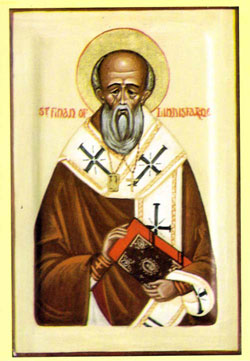
Feastday: February 17
Death: 661
Finan of Lindisfarne Irish by birth, St. Finan of Lindisfarne became a monk at Iona and upheld the Celtic traditions against the encroachment of Roman usage. Finan baptized Penda, ruler of the Middle Angles, and Sigebert, ruler of Essex. Elected bishop of Lindisfarne in 651, Finan sent missionaries to Mercia and to Essex. He also debated Ronan, an Englishman, about the correct way to calculate the date of Easter. On the Holy Island, he built a wooden cathedral, the roof of which was thatched with seagrass. (A later abbot removed the thatching and covered the building with lead). Finan died in 661, and St. Cuthbert succeeded him as abbot.
"Finan" redirects here. For the surname, see Finan (surname).
Finan of Lindisfarne (died 10 or 17 February 661), also known as Saint Finan, was an Irish monk, trained at Iona Abbey in Scotland, who became the second Bishop of Lindisfarne from 651 until 661.
Life
Finan was appointed to Lindisfarne in 651.
Originally from Ireland, he built on Lindisfarne, a cathedral "in the Irish fashion", employing hewn oak, with a thatched roof, dedicated to St. Peter. He also founded St. Mary's at the mouth of the River Tyne. He converted the kings Sigebert of Essex and Peada of the Middle Angles to Christianity. Bede is the main source for Finan's life. He is specially noted by Bede as having borne an important part in the conversion of the northern Saxons.
The breviary of Aberdeen styles him "a man of venerable life, a bishop of great sanctity, an eloquent teacher ... remarkable for his training in virtue and his liberal education, surpassing all his equals in every manner of knowledge as well as in circumspection and prudence, but chiefly devoting himself to good works and presenting in his life, a most apt example of virtue". Finan ordained St. Cedd bishop of the East-Saxons, having called two other bishops to assist at his consecration.
The Abbey of Whitby, his chief foundation, was the scene of the famous Paschal controversy, which resulted in the withdrawal of the Irish monks from Lindisfarne.
Finan was active for some time at a monastery on Church Island on Lough Currane in County Kerry; today it is known as St. Finan's Church. To the south of the lake is Inis Uasal (Noble Island), an island which is dedicated to him.
Finan died in 661, and was buried at Lindisfarne, having held that see ten years.
Veneration
Finan's feast day is celebrated upon 9 January.
Citations
- ^ Saint Cuthbert: With an Account of the State in which His Remains Were Found Upon the Opening of His Tomb in Durham Cathedral, in the Year MDCCCXXVII. G. Andrews. 1928. p. 11.
- ^ Fryde, et al. Handbook of British Chronology p. 219
- ^ Grattan-Flood, William. "St. Finan." The Catholic Encyclopedia. Vol. 6. New York: Robert Appleton Company, 1909. 12 May 2013
- ^ Walsh New Dictionary of Saints p. 203
- ^ Kirby Earliest English Kings pp. 79–80
- ^ Webb, Alfred. A Compendium of Irish Biography, M. H. Gill & Son, Dublin, 1878
- ^ Carver, Martin (2006). The cross goes north: processes of conversion in northern Europe, AD 300-1300. Boydell Press. p. 134. ISBN 1-84383-125-2.





